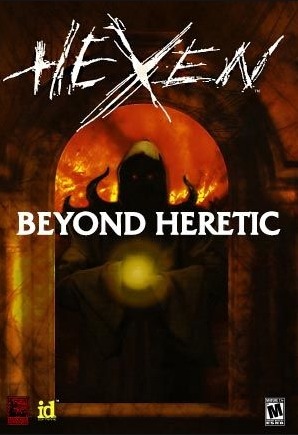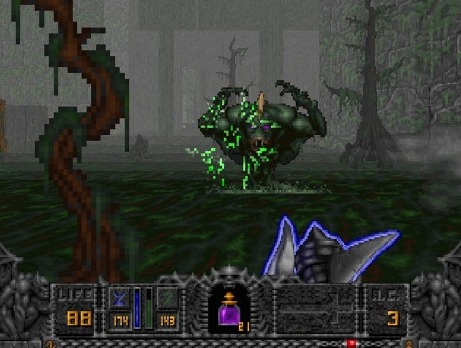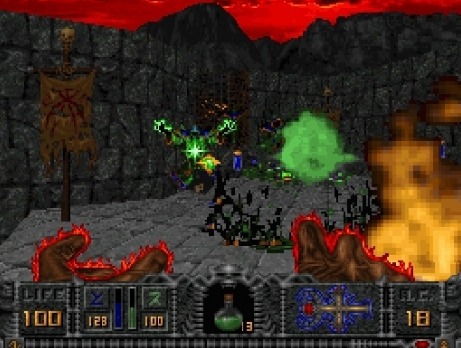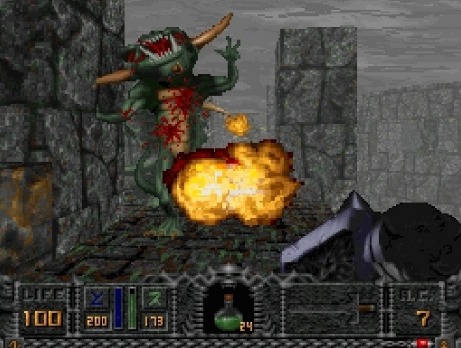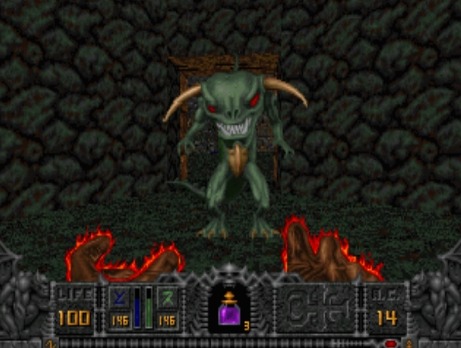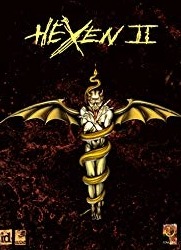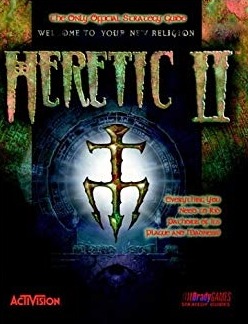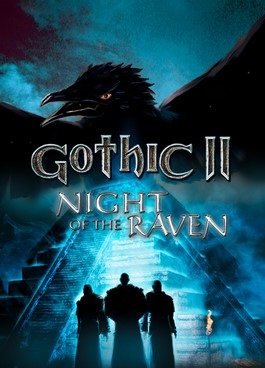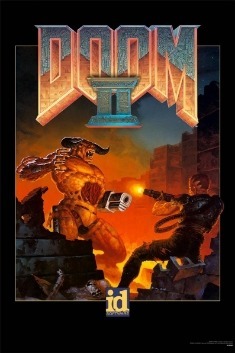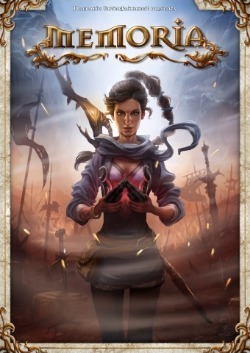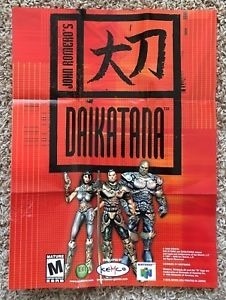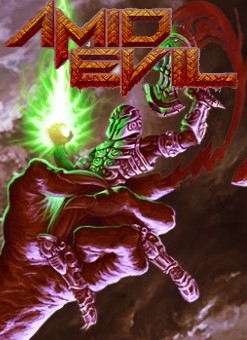Hexen: Beyond Heretic is a dark fantasy first-person shooter video game developed by Raven Software and published by id Software through GT Interactive Software on October 30, 1995. It is the sequel to 1994's Heretic, and the second game in Raven Software's "Serpent Riders" trilogy, which culminated with Hexen II. The title comes from the German noun Hexen, which means "witches", and/or the verb hexen, which means "to cast a spell". Game producer John Romero stated that a third, unreleased game in this series was to be called Hecatomb.
Hexen: Beyond Heretic met with highly positive reviews upon release, though the various 1997 console ports were negatively received due to issues with frame rate and controls and the aging of the game itself. Critical plaudits for the game centered on the non-linear level design and the selection of three playable characters, each offering a distinct gameplay experience.
Plot
Following the tale of D'Sparil's defeat in Heretic, Hexen takes place in another realm, Cronos, which is besieged by the second of the three Serpent Riders, Korax. Three heroes set out to destroy Korax. The player assumes the role of one such hero. Throughout the course of his quest, he travels through elemental dungeons, a wilderness region, a mountainside seminary, a large castle, and finally a necropolis, before the final showdown with the Serpent Rider.
Gameplay
A new series feature introduced in Hexen is the choice of three character classes. Players may choose to play as a fighter (Baratus), a cleric (Parias), or a mage (Daedolon). Each character has unique weapons and physical characteristics, lending an additional degree of variety and replay value to the game. The Fighter relies mainly on close quarter physical attacks with weapons both mundane and magical in nature, and is tougher and faster than the other characters. The Mage uses an assortment of long-range spells, whose reach is counterbalanced by the fact that he is the most fragile and slowest moving of the classes. The Cleric arms himself with a combination of both melee and ranged capabilities, being a middle ground of sorts between the other two classes. Additionally, certain items, such as the flechette (poison gas bomb), behave differently when collected and used by each of the classes, functioning in a manner better suiting their varying approach to combat.
Hexen introduces "hub" levels to the series, wherein the player can travel back and forth between central hub levels and connected side levels. This is done in order to solve larger-scale puzzles that require a series of items or switches to be used. The player must traverse through a hub in order to reach a boss and advance to the next hub.
The inventory system returns from Heretic with several new items such as the "ring of repulsion" which pushes enemies away from the player and the "icon of the defender" which provides invincibility to each class in a different manner.
Development
Like Heretic, Hexen was developed on NeXTSTEP. Hexen uses a modified version of the Doom engine, which allows looking up and down, network play with up to eight players, and the choice of three character classes. It also popularized the "hub system" of level progression in the genre of first-person shooter games. Unlike previous games, which had relied purely on General MIDI for music, Hexen is also able to play tracks from a CD. The game's own CD contained a soundtrack in an audio format that was exactly the same as the MIDI soundtrack, but played through a high-quality sound module. However, the most significant improvement was the addition of wall translation, rotation, and level scripting.
Reception
Heretic and Hexen shipped a combined total of roughly 1 million units to retailers by August 1997.
Reviewing the PC version, Maximum remarked that Hexen sets itself apart from other "3D slashers" with its selection of characters and novel approach to level design, which "leads to your character choosing their path rather than being guided around a rather linear series of rooms, proving that 3D games have matured". They also commented that the gameplay is consistently intense due to the difficulty of the enemies, the variety of weapons and power-ups, and the sheer size and breadth of the levels. They gave the game 5 out of 5 stars and their "Maximum Game of the Month" award. A reviewer for Next Generation opined that "Hexen takes everything that was good about Heretic, and makes it even better." He commented that the ability to choose between three different character classes gives the game replay value, something that had been missing from first-person shooters up until then, and though the graphics are blocky and pixelated, the "eerily lifelike" sound effects make up for it to a large extent. Like Maximum, he praised the non-linear level design and concluded the game to be a must-have for any first-person shooter fan. Chris Hudak, citing the differing abilities of the three playable characters, called Hexen "Slicker, smarter and more stylish than Doom---with all the killing and three times the replay value."
Computer Games Strategy Plus named Hexen the best "First-Person Action" title of 1995. It was also a runner-up for Computer Gaming World's 1995 "Action Game of the Year" award, which ultimately went to Crusader: No Remorse. The editors called it "another Doom bloodfest distinguished by its fantasy setting and the fact that it let you play as either a fighter, priest or mage, each with unique attributes and weapons".
The Saturn version was far less positively received. A review in Next Generation reasoned that, "Like oil and water, Doom-style games and console conversions don't mix well. Unless the programmers are willing to rewrite the graphics engine from scratch, PC ports suffer from getting cramped into too little memory and neglecting the console's native 3D hardware." The reviewer recommended Saturn owners instead try PowerSlave or Ghen War, first-person shooters specifically designed for the console. Shawn Smith and Sushi-X of Electronic Gaming Monthly similarly said the game had not converted well from PC. Others described the Saturn port as an exact conversion, and argued the problem was simply that Hexen was too old a game to be released for console in 1997 without any improvements. Though they disagreed on why, most critics agreed that the Saturn version suffers from pixelated graphics, dramatic drops in frame rate, and cumbersome controls. Scary Larry of GamePro gave it a mixed review, summarizing that "although it doesn't live up to PowerSlave's standards, it's still decent fun." John Broady of GameSpot gave a slightly more dismal assessment: "Despite these glaring deficiencies, Hexen nonetheless offers enough enhancements over the standard shooter to warrant a rental, especially for fans of role-playing games who thirst for real-time action. ... But for the rest, the Saturn version of Hexen is a classic game of too little and too late." Rich Leadbetter of Sega Saturn Magazine and James Price of Saturn Power defended the Saturn version, commenting that while it is not outstanding, it is far superior to the Saturn version of Doom, which was released at roughly the same time. Price was particularly enthusiastic about the link cable-enabled multiplayer mode.
